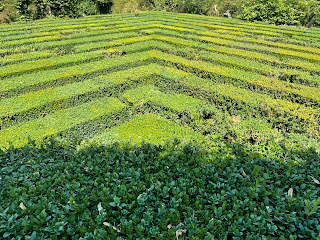Recently, in a beautiful review paper on transit times (Benettin et al. 2022), to describe the difference between the two distribution, was used the concept of celerities by saying that the backward transit time distribution deals with the velocity of water, the response time distribution deals with the celerity.
However, this is not the case. The simplest form (one single output) Niemi's relation reads in fact:$$ IUH(t-t_i|t_{i}) J(t_{i}) \equiv p_Q(t-t_i,t_{i}) Q(t) $$
where $IUH$ is the travel time distribution, $T=t-t_i$ is the transit time, $t_i$ the precipitation instant, $J$ is the precipitation, $p_Q(T,t_{i})$ the backward travel time distribution and $Q(t)$ is the discharge.
Therefore if the $IUH$ is affected by celerities, also the $p_Q$ must be, unless precipitation and discharge are nor mysteriously related in a way to cancel its effect on the right side of the identity. It is much easy to understand that the effect of celerities is inscribed in the time variability of both the distributions, $IUH$ and $Q$
References
Benettin, Paolo, Nicolas B. Rodriguez, Matthias Sprenger, Minseok Kim, Julian Klaus, Ciaran J. Harman, Ype van der Velde, et al. 2022. “Transit Time Estimation in Catchments: Recent Developments and Future Directions.” Water Resources Research 58 (11). https://doi.org/10.1029/2022wr033096.
Rigon, Riccardo, Marialaura Bancheri, Giuseppe Formetta, and Alban de Lavenne. 2016a. “The Geomorphological Unit Hydrograph from a Historical-Critical Perspective.” Earth Surface Processes and Landforms, EGU Reprint Series, 41 (1): 27–37. https://doi.org/10.1002/esp.3855.
Rigon, Riccardo, Marialaura Bancheri, and Timothy R. Green. 2016b. “Age-Ranked Hydrological Budgets and a Travel Time Description of Catchment Hydrology.” Hydrology and Earth System Sciences Discussions, May, 1–22. https://doi.org/10.5194/hess-2016-210.
Rigon, Riccardo, and Marialaura Bancheri. 2021. “On the Relations between the Hydrological Dynamical Systems of Water Budget, Travel Time, Response Time and Tracer Concentrations.” Hydrological Processes 35 (1). https://doi.org/10.1002/hyp.14007.
Rigon, Riccardo, and Marialaura Bancheri. 2021b. Supplemental material of “On the Relations between the Hydrological Dynamical Systems of Water Budget, Travel Time, Response Time and Tracer Concentrations.” Hydrological Processes 35 (1). https://doi.org/10.1002/hyp.14007.
















